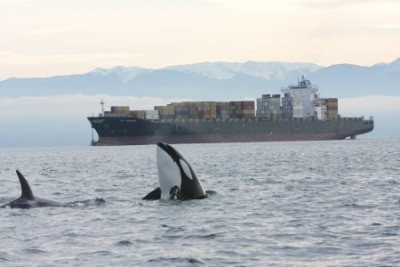Dec 12 2012
Research by scientists at the University of Bath is being used to help inform new EU legislation on levels of underwater noise, with the aim of reducing the impact of noise pollution on marine wildlife.
 Researchers looked at the best ways of processing underwater noise data that showed the impact on marine wildlife (Credit: Mark Malleson)
Researchers looked at the best ways of processing underwater noise data that showed the impact on marine wildlife (Credit: Mark Malleson)
Shipping, seismic surveys for oil exploration and even the installation of offshore wind turbines all produce underwater noise that has been shown to increase stress levels of wildlife. This can affect the long-term health of marine animals, creating a negative impact on the marine food chain and the fishing industry.
The EU Marine Strategy Framework Directive aims to protect the marine environment by assessing levels of indicators including noise pollution and defining what constitutes ‘good environmental status’. Once the baseline levels of underwater noise have been defined, legislation will be used to set standards to reduce the levels by 2020.
The researchers at Bath, in collaboration with Ocean Networks Canada, looked at different statistical methods of measuring underwater noise and assessed which method was most relevant to measuring potential impacts on marine life.
Nathan Merchant, a third year PhD student from the University’s Department of Physics, explained: “It has been shown that whales have increased stress hormones in their blood when they are exposed to high noise levels. This could have a negative impact on the health of whales (as it does in humans), and could ultimately contribute to population decline of endangered species.
“Noise also affects other sea creatures such as crabs and fish, which could have a knock-on effect for the rest of the food chain and the fishing industry.
“The new EU legislation aims to measure trends in underwater noise levels from year to year. The challenge for us was to identify a robust technique to calculate the average noise levels over the year in a way which reflected levels of potential impact on marine animals.”
The researchers looked at a range of statistical methods used to process noise data collected over four months by an underwater microphone located in the Strait of Georgia, near Vancouver, a major shipping route for western Canada.
The research was made possible by funding from the Engineering & Physical Sciences Research Council and labour and equipment from Ocean Networks Canada and Ocean Sonics.
Nathan Merchant said: “Noise is measured in decibels, a logarithmic unit of measurement. This means deciding whether to take an average of your data before or after conversion into decibels can make a big difference to the end result.
“Our study recommends using the mean average of the data before converting it to decibels because it best reflects the way that marine mammal hearing responds to noise exposure.”
The study’s recommendations, published in the Journal of the Acoustical Society of America, are now being considered by the Technical Subgroup on Underwater Noise to inform the EU’s new Marine Strategy Framework Directive.